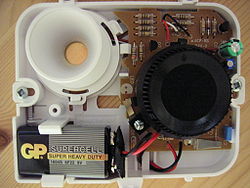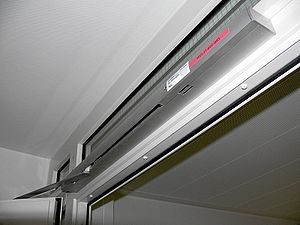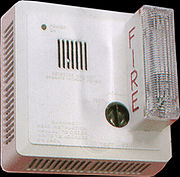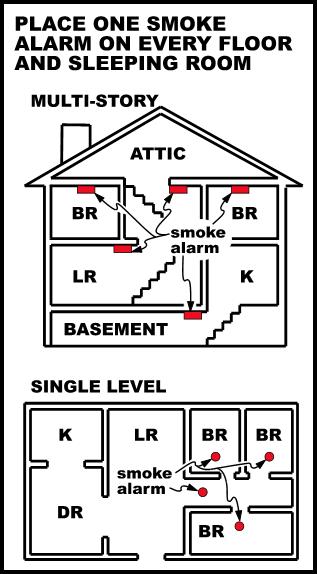News & Reading >>Knowledge >>Smoke Detector & Smoke Alarm Introduction.
What is smoke detector? | How do smoke alarms work? | China smoke detector and smoke alarm

A smoke detector is a device that detects smoke. Commercial, industrial, and mass residential devices issue a signal to a fire alarm system, while household detectors, known as smoke alarms, generally issue a local audible and/or visual alarm from the detector itself. Smoke detectors are typically housed in a disk-shaped plastic enclosure about 150 millimetres (6 in) in diameter and 25 millimetres (1 in) thick, but the shape can vary by manufacturer or product line. Most smoke detectors work either by optical detection (photoelectric) or by physical process (ionization), while others use both detection methods to increase sensitivity to smoke. Smoke detectors in large commercial, industrial, and residential buildings are usually powered by a central fire alarm system, which is powered by the building power with a battery backup. However, in many single family detached and smaller multiple family housings, a smoke alarm is often powered only by a single disposable battery.
History
The first automatic electric fire alarm was invented in 1890 by Francis Robbins Upton (US patent no. 436,961). Upton was an associate of Thomas Edison, although there is no evidence that Edison contributed to this project.
In the late 1930s the Swiss physicist Walter Jaeger tried to invent a sensor for poison gas. He expected that gas entering the sensor would bind to ionized air molecules and thereby alter an electric current in a circuit in the instrument. His device failed: small concentrations of gas had no effect on the sensor's conductivity. Frustrated, Jaeger lit a cigarette—and was soon surprised to notice that a meter on the instrument had registered a drop in current. Smoke particles had apparently done what poison gas could not. Jaeger's experiment was one of the advances that paved the way for the modern smoke detector.
It was 30 years, however, before progress in nuclear chemistry and solid-state electronics made a cheap sensor possible. While home smoke detectors were available during most of the 1960s, the price of these devices was rather high. Before that, alarms were so expensive that only major businesses and theaters could afford them.
The first truly affordable home smoke detectors were invented by Duane D. Pearsall and Stanley Bennett Peterson in 1965, featuring individual battery powered units that could be easily installed and replaced. The first units for mass production came from the manufacturing mind of Stanley B. Peterson in 1975 at Duane Pearsall’s company in Lakewood, Colorado, named Statitrol Corporation.
These first units were made from strong fire resistant steel and shaped much like a bee's hive. The battery was a rechargeable specialized unit created by Gates Energy. The need for a quick replace battery didn't take long to show itself and the rechargeable was replaced with a pair of double A's along with a plastic shell encasing the detector. Daniel Peterson, son to Stanley, was the manufacturing floor supervisor and shipping lead for quality control setting a new record for small business PCB electro/mechanical manufacturing during the time (1975–1977). The small assembly line sent close to 500 units per day before Statitrol sold its invention to Emerson Electric in 1980 and Sears’s retailers picked up full distribution of the 'now required in every home' smoke detector.
The first commercial smoke detectors came to market in 1969. Today they are installed in 93% of US homes and 85% of UK homes. However it is estimated that any given time over 30% of these alarms don't work, as users remove the batteries, or forget to replace them.
Although commonly attributed to NASA, smoke detectors were not invented as a result of the space program, though a variant with adjustable sensitivity was developed for Skylab.
Design
Optical - photoelectric

An optical detector is a light sensor. When used as a smoke detector, it includes a light source (incandescent bulb or infrared LED), a lens to collimate the light into a beam, and a photodiode or other photoelectric sensor at an angle to the beam as a light detector. In the absence of smoke, the light passes in front of the detector in a straight line. When smoke enters the optical chamber across the path of the light beam, some light is scattered by the smoke particles, directing it at the sensor and thus triggering the alarm.
Also seen in large rooms, such as a gymnasium or an auditorium, are devices to detect a projected beam. A unit on the wall sends out a beam, which is either received by a receiver or reflected back via a mirror. When the beam is less visible to the "eye" of the sensor, it sends an alarm signal to the fire alarm control panel.
Optical smoke detectors are quick in detecting particulate (smoke) generated by smoldering (cool, smoky) fires. Many independent tests indicate that optical smoke detectors typically detect particulates (smoke) from hot, flaming fires approximately 30 seconds later than ionization smoke alarms.
They are less sensitive to false alarms from steam or cooking fumes generated in kitchen or steam from the bathroom than are ionization smoke alarms. For the aforementioned reason, they are often referred to as 'toast proof' smoke alarms.
Ionization

This type of detector is cheaper than the optical detector; however, it is sometimes rejected because it is more prone to false (nuisance) alarms than photoelectric smoke detectors. It can detect particles of smoke that are too small to be visible. It includes about 37 kBq or 1 µCi of radioactive americium 241 (241Am), corresponding to about 0.3 µg of the isotope. The radiation passes through an ionization chamber, an air-filled space between two electrodes, and permits a small, constant current between the electrodes. Any smoke that enters the chamber absorbs the alpha particles, which reduces the ionization and interrupts this current, setting off the alarm.
241Am, an alpha emitter, has a half-life of 432 years. This means that it does not have to be replaced during the useful life of the detector, and also makes it safe for people at home, since it is only slightly radioactive. Alpha radiation, as opposed to beta and gamma, is used for two additional reasons: Alpha particles have high ionization, so sufficient air particles will be ionized for the current to exist, and they have low penetrative power, meaning they will be stopped by the plastic of the smoke detector and/or the air.
Air-sampling
An air-sampling smoke detector is capable of detecting microscopic particles of smoke. Most air-sampling detectors are aspirating smoke detectors, which work by actively drawing air through a network of small-bore pipes laid out above or below a ceiling in parallel runs covering a protected area. Small holes drilled into each pipe form a matrix of holes (sampling points), providing an even distribution across the pipe network. Air samples are drawn past a sensitive optical device, often a solid-state laser, tuned to detect the extremely small particles of combustion. Air-sampling detectors may be used to trigger an automatic fire response, such as a gaseous fire suppression system, in high-value or mission-critical areas, such as archives or computer server rooms.
Most air-sampling smoke detection systems are capable of a higher sensitivity than spot type smoke detectors and provide multiple levels of alarm threshold, such as Alert, Action, Fire 1 and Fire 2. Thresholds may be set at levels across a wide range of smoke levels. This provides earlier notification of a developing fire than spot type smoke detection, allowing manual intervention or activation of automatic suppression systems before a fire has developed beyond the smoldering stage, thereby increasing the time available for evacuation and minimizing fire damage.
Carbon monoxide and carbon dioxide detection
Some smoke alarms use a carbon dioxide sensor or carbon monoxide sensor in order to detect extremely dangerous products of combustion. However, not all smoke detectors that are advertised with such gas sensors are actually able to warn of poisonous levels of those gases in the absence of a fire.
Performance differences
Optical or "toast-proof" smoke detectors are generally quicker in detecting particulate (smoke) generated by smoldering (cool, smokey) fires. Ionization smoke detectors are generally quicker in detecting particulate (smoke) generated by flaming (hot) fires.
According to fire tests conformant to EN 54, normally the CO2 cloud from smoke can be detected before particulate.
Obscuration is a unit of measurement that has become the standard definition of smoke detector sensitivity. Obscuration is the effect that smoke has on reducing visibility. Higher concentrations of smoke result in higher obscuration levels, lowering visibility.
| Typical smoke detector obscuration ratings | |
| Type of Detector | Obscuration Level |
|---|---|
| Ionization | 2.6-5.0% obs/m (0.8-1.5% obs/ft) |
| Photoelectric | 6.5-13.0% obs/m (2-4% obs/ft) |
| Beam | 3% obs/m (0.9% obs/ft) |
| Aspirating | 0.005-20.5% obs/m (0.0015-6.25% obs/ft) |
| Laser | 0.06-6.41% obs/m (0.02-2.0% obs/ft) |
Commercial smoke detectors

Commercial smoke detectors are either conventional or analog addressable, and are wired up to security monitoring systems or fire alarm control panels (FACP). These are the most common type of detector, and usually cost a lot more than a household smoke alarms. They exist in most commercial and industrial facilities, such as high rises, ships and trains. These detectors don't need to have built in alarms, as alarm systems can be controlled by the connected FACP, which will set off relevant alarms, and can also implement complex functions such as a staged evacuation.
Conventional
Conventional smoke detectors are so called because they are the older type of smoke detectors. The detector communicates with the fire alarm control panel simply by changing state from high impedance to low impedance when smoke is detected. Smoke detectors are typically wired together up to 40 detectors on each zone or loop and a single fire alarm control panel can usually monitor a number of zones or loops which can be arranged to correspond to different areas of a building. In the event of a fire, the fire alarm control panel is able to identify which loop contains the detector or detectors in alarm, but it's not able to identify which individual detector or detectors is in an alarm state.
Analog addressable
Analog addressable detectors allow an FACP, and therefore fire fighters, to know the exact location of an alarm. These are usually more expensive than conventional detectors, and offer extra options, such as a custom level of sensitivity.
Standalone smoke alarms
The main function of a standalone smoke alarm is to alert persons at risk. Several methods are used and documented in industry specifications published by Underwriters Laboratories[11] Alerting methods include:
- Audible tones
- usually around 3200 Hz due to component constraints (Audio advancements for persons with hearing impairments have been made; see External links)
- 85 dBA at 10 feet
- Spoken voice alert
- Visual strobe lights
- 110 candela output
- Tactile stimulation, e.g., bed or pillow shaker (No standards exist as of 2008 for tactile stimulation alarm devices.)
Some models have a hush or temporary silence feature that allows silencing without removing the battery. This is especially useful in locations where false alarms can be relatively common (i.e. due to "toast burning") or users could remove the battery permanently to avoid the annoyance of false alarms.
While current technology is very effective at detecting smoke and fire conditions, the deaf and hard of hearing community has raised concerns about the effectiveness of the alerting function in awakening sleeping individuals in certain high risk groups such as the elderly, those with hearing loss and those who are intoxicated. Between 2005 and 2007, research sponsored by the NFPA has focused on understanding the cause of a higher number of deaths seen in such high risk groups. Initial research into the effectiveness of the various alerting methods is sparse. Research findings suggest that a low frequency (520 Hz) square wave output is significantly more effective at awakening high risk individuals. Wireless Wi-Safe smoke and carbon monoxide detectors linked to alert mechanisms such as vibrating pillow pads, strobes and remote warning handsets have been found to support the groups above.
Batteries

Most residential smoke detectors run on 9-volt alkaline or carbon-zinc batteries. When these batteries run down, the smoke detector becomes inactive. Most smoke detectors will signal a low-battery condition. The alarm may chirp at intervals if the battery is low, though if there is more than one unit within earshot, it can be hard to locate. It is common, however, for houses to have smoke detectors with dead batteries. It is estimated, in the UK, that over 30% of smoke alarms may have dead or removed batteries. As a result, public information campaigns have been created to remind people to change smoke detector batteries regularly. In Australia, for example, it is advertised that all smoke alarm batteries should be replaced on the first day of April every year. In regions using daylight saving time, these campaigns may suggest that people change their batteries when they change their clocks or on a birthday.
Some detectors are also being sold with a lithium battery that can run for about 7 to 10 years, though this might actually make it less likely for people to change batteries, since their replacement is needed so infrequently. By that time, the whole detector may need to be replaced. Though relatively expensive, user-replaceable 9-volt lithium batteries are also available.
Common NiMH and NiCd rechargeable batteries have a high self-discharge rate, making them unsuitable for use in smoke detectors. This is true even though they may provide much more power than alkaline batteries if used soon after charging, such as in a portable stereo. Also, a problem with rechargeable batteries is a rapid voltage drop at the end of their useful charge. This is of concern in devices such as smoke detectors, since the battery may transition from "charged" to "dead" so quickly that the low-battery warning period from the detector is either so brief as to go unnoticed, or may not occur at all.
The United States' National Fire Protection Association (NFPA), recommends that home-owners replace smoke detector batteries with a new battery at least once per year, when it starts chirping (a signal that its charge is low), or when it fails a test, which the NFPA recommends to be carried out at least once per month by pressing the "test" button on the alarm.
Reliability
In 2004, NIST issued a comprehensive report. The report concludes, among other things, that "smoke alarms of either the ionization type or the photoelectric type consistently provided time for occupants to escape from most residential fires", and "consistent with prior findings, ionization type alarms provided somewhat better response to flaming fires than photoelectric alarms, and photoelectric alarms provided (often) considerably faster response to smoldering fires than ionization type alarms".
The NFPA strongly recommends the replacement of home smoke alarms every 10 years. Smoke alarms become less reliable with time, primarily due to aging of their electronic components, making them susceptible to nuisance false alarms. In ionization type alarms, decay of the 241Am radioactive source is a negligible factor, as its half-life is far greater than the expected useful life of the alarm unit.
Regular cleaning can prevent false alarms caused by the build up of dust or other objects such as flies, particularly on optical type alarms as they are more susceptible to these factors. A vacuum cleaner can be used to clean ionization and optical detectors externally and internally. However, on commercial ionisation detectors it is not recommended for a lay person to clean internally. To reduce false alarms caused by cooking fumes, use an optical or 'toast proof' alarm near the kitchen.
A jury in the United States District Court for the Northern District of New York decided in 2006 that First Alert and its parent company, BRK Brands, was liable for millions of dollars in damages because the ionization technology in the smoke alarm in the Hackert's house was defective, failing to detect the slow-burning fire and choking smoke that filled the home as the family slept.
Installation and placement

In the United States, most state and local laws regarding the required number and placement of smoke detectors are based upon standards established in Article 72 of the NFPA fire code.
Laws governing the installation of smoke detectors vary depending on the locality. Homeowners with questions or concerns regarding smoke detector placement may contact their local fire marshal or building inspector for assistance. However, some rules and guidelines for existing homes are relatively consistent throughout the developed world. For example, Canada and Australia require a building to have a working smoke detector on every level. The United States requires smoke detectors on every habitable level and within the vicinity of all bedrooms. Habitable levels include attics that are tall enough to allow access.
In new construction, minimum requirements are typically more stringent. All smoke detectors must be hooked directly to the electrical wiring, be interconnected and have a battery backup. In addition, smoke detectors are required either inside or outside every bedroom, depending on local codes. Smoke detectors on the outside will detect fires more quickly, assuming the fire does not begin in the bedroom, but the sound of the alarm will be reduced and may not wake some people. Some areas also require smoke detectors in stairways, main hallways and garages.
Wired units with a third "interconnect" wire allow a dozen or more detectors to be connected, so that if one detects smoke, the alarms will sound on all the detectors in the network, improving the chances that occupants will be alerted, even if they are behind closed doors or if the alarm is triggered one or two floors removed from their location. Wired interconnection may only be practical for use in new construction, especially if the wire needs to be routed in areas that are inaccessible without cutting open walls and ceilings. As of the mid-2000s, development has begun on wirelessly networking smoke alarms, using technologies such as ZigBee, which will allow interconnected alarms to be easily retrofitted in a building without costly wire installations. Some wireless systems using Wi-Safe technology will also detect smoke or carbon monoxide through the detectors, which simultaneously alarm themselves with vibrating pads, strobes and remote warning handsets. As these systems are wireless they can easily be transferred from one property to another.
In the UK the placement of detectors are similar however the installation of smoke alarms in new builds need to comply to the British Standards BS5839 pt6. BS 5839: Pt.6: 2004 recommends that a new-build property consisting of no more than 3 floors (less than 200sqm per floor)) should be fitted with a Grade D, LD2 system. Building Regulations in England,Wales & Scotland recommend that BS 5839: Pt.6 should be followed, but as a minimum a Grade D, LD3 system should be installed. Building Regulations in Northern Ireland require a Grade D, LD2 system to be installed, with smoke alarms fitted in the escape routes and the main living room and a heat alarm in the kitchen, this standard also requires all detectors to have a main supply and a battery back up.



